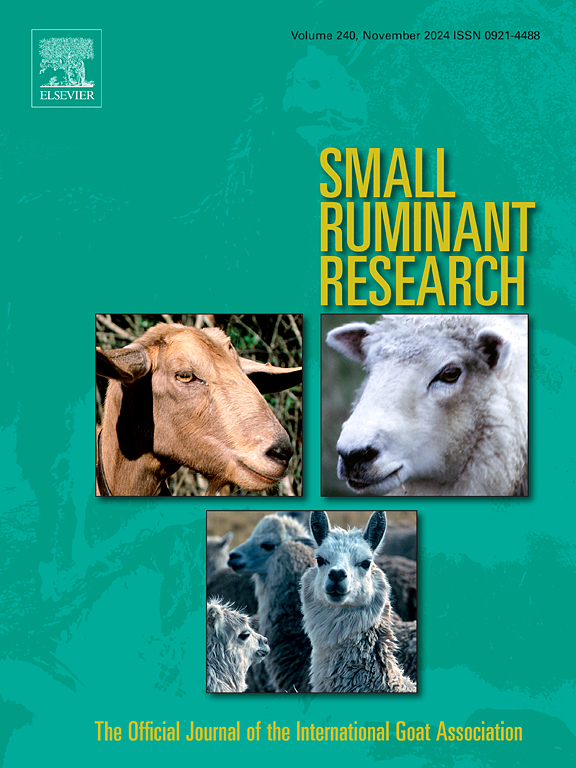Variation due to additive, dominance and imprinting genetic effects in body weight gain of Baluchi sheep
IF 1.6
3区 农林科学
Q2 AGRICULTURE, DAIRY & ANIMAL SCIENCE
引用次数: 0
Abstract
The aim was to estimate relative contribution of additive, dominance and imprinting genetic effects to the phenotypic variation of body weight gain in different growth phases, namely from birth to weaning (BWGa), weaning to 9 months of age (BWGb) and weaning to 12 months of age (BWGc) in Baluchi sheep. This was done in a two-step process. In the first step, each trait was analysed with 12 different animal models which included different combinations of additive genetic, dominance genetic and maternal effects. The best model (Model I) was selected with Akaike Information Criterion (AIC). In the second step, three additional models were fitted by adding maternal imprinting, paternal imprinting, or both (models 13–15) to the Model I. Predictive ability of models was measured using the mean squared error of prediction (MSE) and Pearson's correlation coefficient between the real and predicted values of observations (r(,)). Correlations between traits were estimated using bi-variate analyses. In the first step, for all traits studied, including dominance genetic effects in the model resulted to a significantly better data fit and enhanced predictive ability of the model (higher r(,) and lower MSE). Also it resulted to a significant decrease in the residual variance up to 24 %. However, accounting for dominance genetic effects, significantly increased the computing time and required memory. In the second step, for BWGa, adding maternal imprinting effects to the model I resulted to increase in the likelihood and predictive ability of the model as well as 40 % decrease in the additive genetic variance. Estimates of dominance heritability (), were 0.19, 0.15 and 0.20 for BWGa, BWGb and BWGc, respectively. Additive heritability (), were 0.08, 0.08 and 0.07 for BWGa, BWGb and BWGc, respectively. For BWGa, maternal imprinting heritability () was 0.08. While additive genetic correlations were all positive and high, dominance genetic correlation between BWGb and BWGc was positively high and between other pairs of traits was negatively high. For all traits studied, correlation between breeding values obtained from models with/without dominance genetic effect was close to unity (0.99) but between breeding values obtained from models with/without imprinting effects deviated from unity (0.85 for BWGa) indicating change in ranking of top animals across models. It was concluded that dominance and imprinting effects needed to be included in the genetic evaluation models for genetic evaluation of growth-related traits in Baluchi lambs.
加性、显性和印迹遗传效应对俾路支绵羊增重的影响
目的是研究加性、显性和印迹遗传效应对俾路支绵羊出生至断奶(BWGa)、断奶至9月龄(BWGb)和断奶至12月龄(BWGc)不同生长阶段体重增加表型变异的相对贡献。这个过程分两步完成。首先,用12种不同的动物模型对每个性状进行分析,其中包括加性遗传、显性遗传和母性效应的不同组合。采用赤池信息准则(Akaike Information Criterion, AIC)选择最佳模型(model I)。在第二步中,通过在模型1中添加母亲印迹、父亲印迹或两者(模型13-15)来拟合另外三个模型。模型的预测能力通过预测均方误差(MSE)和观测值实值与预测值之间的Pearson相关系数(r(y,y´))来衡量。利用双变量分析估计性状之间的相关性。在第一步中,对于所研究的所有性状,包括模型中的显性遗传效应,可以显著提高数据拟合效果,增强模型的预测能力(r(y,y -)较高,MSE较低)。此外,它还导致残差显著降低,最高可达24%。然而,考虑到显性遗传效应,显著增加了计算时间和所需的内存。第二步,对于BWGa,在模型I中加入母体印迹效应,使模型的似然性和预测能力提高,可加性遗传方差降低40%。BWGa、BWGb和BWGc的显性遗传力(hd2)分别为0.19、0.15和0.20。BWGa、BWGb和BWGc的加性遗传力(ha2)分别为0.08、0.08和0.07。BWGa的母体印迹遗传力(hmi2)为0.08。加性遗传相关均为高正相关,而体重指数与体重指数间的显性遗传相关为高正相关,其他性状间的显性遗传相关为高负相关。在所有性状中,具有和不具有显性遗传效应的模型的育种值之间的相关系数接近于1(0.99),而具有和不具有印迹效应的模型的育种值之间的相关系数偏离1(0.85),表明各模型中顶级动物的排名发生了变化。由此可见,在对俾路支羔羊生长相关性状进行遗传评价时,需要将显性效应和印迹效应纳入遗传评价模型。
本文章由计算机程序翻译,如有差异,请以英文原文为准。
求助全文
约1分钟内获得全文
求助全文
来源期刊

Small Ruminant Research
农林科学-奶制品与动物科学
CiteScore
3.10
自引率
11.10%
发文量
210
审稿时长
12.5 weeks
期刊介绍:
Small Ruminant Research publishes original, basic and applied research articles, technical notes, and review articles on research relating to goats, sheep, deer, the New World camelids llama, alpaca, vicuna and guanaco, and the Old World camels.
Topics covered include nutrition, physiology, anatomy, genetics, microbiology, ethology, product technology, socio-economics, management, sustainability and environment, veterinary medicine and husbandry engineering.
 求助内容:
求助内容: 应助结果提醒方式:
应助结果提醒方式:


